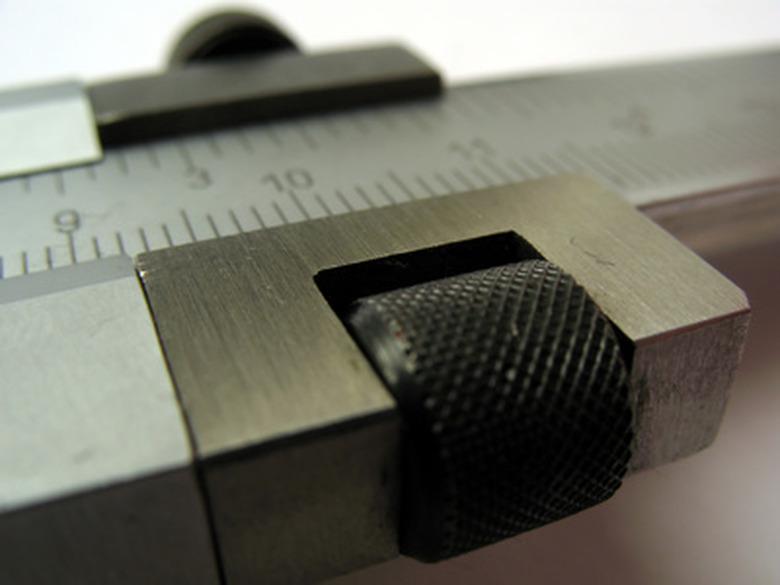How To Calculate Steel Gauge To Inches
Sheet steel is steel formed into thin flat pieces which come in sheets or in rolls and is used for metalworking. Steel sheets can be made of cold-rolled steel, galvanized steel or stainless steel. Standard sheet steel comes in various thicknesses which are classified by steel gauge. Each gauge has a tolerance range to allow for small variances in thickness.
A higher steel gauge value means the material will be thinner and a lower gauge signifies a thicker steel piece. For example, a piece of standard steel with a gauge of three is 0.2319 inches thick while a piece with a steel gauge of 23 will be 0.0269 inches thick. By knowing the weight of the gauge of steel you are working with, you can determine the thickness.
1. Identify the Type of Steel
Determine what type of steel sheet you are working with. Cold-rolled steel sheets do not have any coating or chemical additives. A galvanized steel sheet contains a 0.0010-inch zinc coating. Stainless steel sheets are a mixture of steel with chromium to reduce corrosion. The thickness will vary depending on the type of steel you are measuring.
2. Cut a Sample
Cut a one-square-foot piece (that is, one-foot by one-foot) out of the steel sheet for which you would like to calculate the thickness. This size of the sheet will help make the calculation easier to work with. You can weigh a larger steel piece, but you will have to account for the extra area in your equation.
3. Weigh the Steel
Obtain the weight of the piece of steel you are working with in pounds per square foot. The gauge number and weight of the steel are directly related. The weight is also a necessity in calculating the thickness of the steel. A steel-thickness gauge is based on the Manufacturer's Standard Gauge for Sheet Steel, or the weight of a one-inch thick piece of steel, which is 41.82 pounds per square foot per inch of thickness.
4. Steel Weight to Gauge Formula
Write down the following equation: Weight of steel you are using in pounds per square foot divided by the Manufacturer's Standard Gauge for Sheet Steel in pounds per square foot = Gauge thickness of a steel sheet in gauge decimal in inches or theoretical decimal thickness.
5. Calculating Gauge Thickness in Inches
Solve the equation with a calculator using the weight of steel per square foot you just measured. For example, you know that you have a one-foot-square piece of eight-gauge standard steel. You weighed the steel piece and found it to be 6.875 pounds. Plug this weight into your equation and solve: (6.875 pounds per square foot) divided by 41.82 pounds per square foot = 0.1644 gauge decimal as measured in inches.
6. Identifying U.S. Standard Gauge
Referring back to the Manufacturer's Standard Gauge for Sheet Steel, scan down the sheet steel column to find 0.1644. Looking across to the Gauge column shows that sheet steel with a gauge decimal thickness of 0.1644 inches has a standard gauge number of 8.
Convert Sheet Metal Gauge to mm
Convert Sheet Metal Gauge to mm
Sheet metal specifications may usually be presented as sheet metal gauge, but to ensure accuracy you should provide the actual measurement in inches or millimeters (mm). Gauge to mm charts and gauge calculators are available (see Resources), and the same units are used in specifying inches or mm to gauge wire. But the sheet metal gauge to mm formula isn't difficult, either.
As shown above, find the thickness in inches. To convert from inches to millimeters, use the conversion factor of 25.4 mm=1 inch. Because you want to convert inches to mm, multiply by 25.4 so that the inch units cancel out [inches times (mm÷inches)]. So, multiply the gauge thickness in inches, 0.1644, by the conversion factor 25.4, or
\(0.1644\times 25.4=4.17576\text{ mm}\)
Rounding to significant numbers gives the gauge thickness in millimeters as 4.18.
Things Needed
- 1 piece of sheet steel, 1-foot square (1-foot x 1-foot)
- Scale
- Calculator
TL;DR (Too Long; Didn't Read)
To find the thickness in inches of galvanized steel, add 0.0010 inches on to the theoretical decimal thickness you solved for. For example, you found your gauge decimal thickness to be 0.1644. Adding 0.0010 inches to 0.1644 gives you 0.1654 as a gauge decimal (inches) for the thickness of your galvanized steel sheet. The tolerance will vary according to the thickness of the coat added to the sheet.
References
- Cornell Law School: 15 U.S. Code § 206. Standard Gauge for Sheet and Plate Iron and Steel
- Engineers Edge: Sheet Metal Wire Gauge Sizes Data Chart
- MachineMfg.com: Sheet Metal Gauge Sizes Chart (inch/mm Thickness Conversions)
- University of Washington: Mechanical Properties and Performance of Materials
Cite This Article
MLA
Coswell, Angel. "How To Calculate Steel Gauge To Inches" sciencing.com, https://www.sciencing.com/calculate-steel-gauge-inches-6499870/. 27 December 2020.
APA
Coswell, Angel. (2020, December 27). How To Calculate Steel Gauge To Inches. sciencing.com. Retrieved from https://www.sciencing.com/calculate-steel-gauge-inches-6499870/
Chicago
Coswell, Angel. How To Calculate Steel Gauge To Inches last modified March 24, 2022. https://www.sciencing.com/calculate-steel-gauge-inches-6499870/
